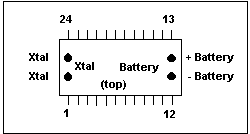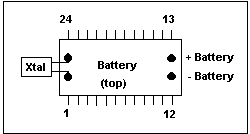
Where Used:
Hard Drivin', Race Drivin', and Steel Talons use both a M48Z02-150 ZeroPower
RAM and a 48T02-150 TimeKeeper RAM.
Why Should I Care?:
In Hard Drivin' and Race Drivin' these parts are used to store the high score table, game settings, and control settings. The TimeKeeper is used to produce a table showing games played by hour and day.
The control setting are stored in the TimeKeeper SRAM. When the part fails you must set up the controls each time you power-up the game. This is a real pain.
Options:
1. Live with it.
2. Don't turn the game off.
3. Isolate VCC for the TimeKeeper and Zeropower RAMs from the
game +5V
with a 1N5817, connect it to a separate 4.0V
power supply through
another 1N5817, and leave the 4.0V power supply
on all the time.
4. Buy a new part.
5. Fix the old part by installing a new battery (Not For the Fainthearted!)
New parts are currently available from Mouser (www.mouser.com)
.
The 48T02-150 Timekeeper, Mouser # 511-M48T0215PC1, costs $19.09
The 48Z02-150 ZeroPower, Mouser # 511-M48Z0215PC1, costs
$ 7.70
The TimeKeeper is expensive, but the Zeropower is reasonable. One solution is use a Zeropower in place of the TimeKeeper. You won't have the clock/calender but at least you won't have to go through the control setup each time you power-up.
If you have a Race Drivin' game, and assuming the TimeKeeper goes first, you may be able to buy time by swapping the TimeKeeper on the Main Board with one of the ZeroPower RAMs on the DSK Board.
If you choose option 1-4 there is no need to read any further. If you
choose option 5, prepare for a small adventure.
History of the Parts:
Both parts were originally made by Mostek. Mostek was acquired by SGS-ATES, which was then acquired by Thomson CSF which changed its name to SGS-Thomson and was then spun out as ST Microelectronics.
According to the ST-Micro Web site they still make both parts. Data
sheets are available at the Web site but they don't make it easy. Go to
their U.S. Web site (www.us.st.com) and
do a text search for "m48t02*" . That brings up another search screen.
Under "Document Index" deselect "All" and check "Datasheets".
Then click on "Search". The data for the M48T02 is part of the datasheet
for the M48T12.
What They Are:
The 48Z02-150 ZeroPower RAM is a 2Kx8 static RAM (150ns) with power control circuitry and a built-in 3.3V lithium battery. When the power control circuitry detects VCC lower than 4.5V, it disables writes to the RAM. When VCC drops below 3.3V it switches to the built-in battery.
The RAM and power control circuitry are in a standard plastic IC package; the battery is encapsulated in what SGS-Thomson calls a 'CAPHAT' which lays over the IC part and attaches to it at the ends. There are two pins that stick up from the top of the IC part between pins 12 and 13 and connect to the battery in the CAPHAT. These pins are not accessible and the battery is not intended to be user replaceable.
The 48T02-150 TimeKeeper RAM is similar to the 48Z02 ZeroPower RAM,
but it also contains a clock/calender. The CAPHAT contains a 32.768 KHz
crystal in addition to the lithium battery. The crystal is connected to
the IC part by two pins that stick up from the top of the IC part between
pins 1 and 24. These pins are also not accessible.
Why I Used Them:
The advantages of these parts is that writes are done at full speed (150ns) and the life of the part is not affected by the number of writes performed.
This is as opposed to EEPROMs where writes take considerably longer (on the order of 4ms) and the parts are only rated for a maximum number of writes (originally 10K, but currently more like 100K).
The lifetime for the TimeKeeper and ZeroPower RAMs is determined by
the lifetime of the battery.
Battery Lifetime:
When I first started using them, in 1984, the data sheets contained charts that related battery lifetime to both temperature and the amount of time the part operated from the battery. Unfortunately, I no longer have the original data sheets, but according to my calculations at the time:
" For a game powered up 50% of the time, in an ambient
of 75 degrees
Fahrenheit, the Lithium Battery can
be expected to last for 6 years. (99%
will still be working.) After 8 years
about 50% can be expected to still work."
This applies only to the ZeroPower RAM. The TimeKeeper draws more current because of the clock/calender. For this reason the clock/calender can be turned off to preserve battery life. This can be done in Self-Test in the screen used to set the time.
The current data sheet simply states that the battery (for both ZeroPower and TimeKeeper):
" has sufficient capacity and storage life to maintain
data and clock functionality
for an accumulated time period of at least
10 years in the absence of power
over the operating temperature range."
The Ambient Operating Temperature is given as 0 - 70 degrees Celcius.
(At higher temperatures the IC current leakage increases but so does the battery capacity. At lower temperatures the IC current leakage decreases, as does the battery capacity.)
The 10 year specification appears to be an improvement over the original specs and may be the result of:
1. a better, lower current design;
2. better batteries than were available in 1984;
3. the Marketing Department.
OK, How Do I replace the Battery?
First some warnings are in order.
Lithium batteries can be dangerous if handled improperly.
1. Do Not Cut it open.
2. Do Not Eat it.
3. Do Not Throw it in a fire, it will probably explode.
4. Do Not Short it out, it will probably explode.
5. Do Not Get it too hot, it will probably explode.
Now, about replacing the battery in a TimeKeeper.
The following is based on a TimeKeeper with a date code of 1988. If you have a more recent part, your milage may vary.
The battery and the 32.768 KHz crystal are in the CAPHAT. They are encapsulated together with epoxy which cannot be melted. However, the remainder of the CAPHAT uses a thermoplastic material which *can* be melted. In fact, it can be melted with a soldering iron. A 23 watt iron is about right. (The IC part uses a thermoset plastic which cannot be remelted.)
The battery (a small lithium coin-type) is located in the end near pins 12 and 13, and takes up about half of the CAPHAT.
The crystal (about the size of a lithium coin-type battery) is located
in the end near pins 1 and 24, and takes up the other half of the CAPHAT.

Using a soldering iron, start at the pin 12 end of the package and start melting the CAPHAT until you have exposed the battery. Be especially careful around the pins where the battery connects to the IC part. They stick up from the top of the IC part between pins 12 and 13.
Once you have removed enough plastic you need to break the epoxy between the battery and the crystal. I used a Dremel with a cutting disc.
A suggestion: The melting plastic can be nasty. Work in a well ventillated area. Outdoors would be nice.
Another suggestion: If you put the TimeKeeper in a IC socket you can work on it without worrying about bending the IC pins.
Once you have exposed the battery, carefully remove it.
If you damage the crystal, or want to use a humongous battery, you will need to remove the crystal as well. That's what I did on my first one.
I replaced the crystal with a small cylindrical crystal (32.768 KHz) from JDR Microdevices. For the battery I used a BR-2325 3V Lithium Coin-type cell, also from JDR. (Radio Shack sells a variety of lithium cells, including small ones that make it unnecessary to remove the crystal.)
The battery I used was so large it took up the entire space on top of
the IC part, so I hung the crystal off the front. (The Main Board accomodates
this with no problem.)

You need to attach the battery so it doesn't fall off. But you also need to be able to remove it when it eventually needs to be replaced. (So don't use epoxy.)
You also need to protect it against condensation which will create a leakage path and cause the battery to expire prematurely.
The following is exactly what I did.
Warning: Be especially careful when you work with the Battery. The Battery is alive. Don't short it out.
1. I soldered the wires from the crystal to the crystal connection pins
on top of
the IC part.
2. I soldered a short length of bare #30 wirewrap wire to the Positive
side of the
battery cell.
3. I placed a piece of double-sticky foam tape on top of the IC part.
4. I mounted the battery with the Positive side against the top of the
foam tape,
making sure the sides of the battery did not short
against any of the wires
sticking up from the IC part.
5. I soldered a piece of #30 wirewrap wire (keeping some insulation
on it) to the
Negative side of the battery.
6. I attached the battery wires to the power pins, observing the correct
polarity.
(The Negative battery wire on top of the IC part
is internally connected to
IC pin 12. It is the only 'top' wire connected to
an IC pin.)
I was especially careful when attaching the battery wires.
The Battery is alive and I
didn't want to short it out.
7. I used clear nail polish to coat the crystal connections and the
battery connections.
I also coated the perimeter of the battery. By this
I mean the space between the
positive case and the negative inner disk.)
8. I liberally applied RTV (silcone rubber-in-a-tube) over the top of
the battery and IC
part. This is to help keep the battery in place
so it doesn't fall off if the
double-sticky tape gives way.
I installed it in my Race Drivin'. It's alive.
In my second TimeKeeper I removed only the battery, being careful not to damage the crystal. The replacement battery I used was a CR-1220, mounting it in the manner already described.
Note: the first two numbers in the lithium coin-cell designation appears
to be the diameter in millimeters. The BR-2325 is 23 mm (0.905") in diameter;
the BR-1220 is 12 mm (0.472") in diameter.
Good luck.
Jed Margolin